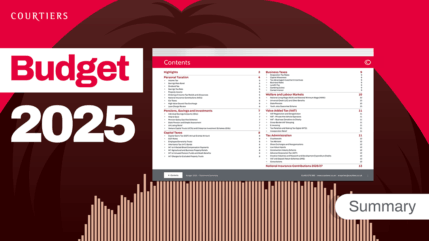Barely had the ink on the Truss government’s ill-fated Growth Plan in September dried before Jeremy Hunt was standing up in the House of Commons to deliver his November Autumn Statement. While the former focused on tax-cutting, the latter was all about tax-raising and was delivered by a new Chancellor with completely different priorities. Meanwhile inflation has hit a 41-year high, while interest rates and with them mortgage rates have risen substantially.
No surprise then that according to Paul Kemsley, Senior Private Client Manager, Courtiers’ Advisers have been particularly busy over the last couple of months, with “a lot more queries from clients.”
So, there was certainly lots to discuss when I sat down with Paul and Graeme Clark, Head of Private Clients for the latest quarterly Adviser Review.
Although November’s Autumn Statement was well-trailed and didn’t contain any surprises, Graeme said its cocktail of tax-raising measures “made it feel a bit like the austerity of 2010.” The main measures are available to view and download here.
Graeme acknowledged that some clients might be concerned about the reduction of the 45% additional rate threshold from £150,000 to £125,140. However, he explained how judicious planning using a combination of different allowances, reliefs and tax breaks could be used mitigate the impact of this measure on clients’ incomes.
Moving on to the reduction in the capital gains tax (CGT) allowance from £12,300 now to £3,000 from April 2024, Graeme said this “creates a bit more of a challenge.” But “what was good”, he continued was that the rates weren’t harmonised with income tax rates “giving us some really good legitimate tax planning tools”.
Even though CGT allowances are due to be reduced next year and then again in the following year, “we will continue” to manage clients’ CGT allowances, said Paul. He emphasised that planning ahead is the key, before explaining how anyone sitting on losses in their portfolio as a result of adverse market movements could, by registering them with HMRC within certain times limits, offset them against CGT gains in future years.

Ensuring clients maximise their allowances (for example, ISAs) and make use of available tax reliefs, such as on pension contributions, were also important ways to mitigate the impact of measures in the Autumn Statement and will be high on Advisers’ agendas before the 2023/24 tax year comes in.
Although all the Autumn Statement headlines focused on tax rises, Graeme says it could have been worse, with fears that the Lifetime Allowance would be reduced from its current £1,073,100 and the ability to take pension commencement lump sums removed both failing to be realised.
The fact that the markets didn’t react adversely to the Autumn Statement and that there’s been something of a recovery in the markets since are also positives for clients, said Graeme.
Indeed, if anything, rather than the measures in the Autumn Statement Paul said that rising interest rates were a more immediate concern for clients.
Graeme said that higher mortgage rates and tighter lending criteria making it more difficult for younger people were a particular concern for some clients. In response to this, he said he’s seeing a trend for more grandparents to help their grandchildren to buy property with lump-sum gifts and by using trusts. “That’s the benefit of the planning that we do. Those plans were put in place 10 or 15 years ago and are only coming to fruition now.”
Enquiries about equity release had also increased, said Graeme, with some clients keen to refinance a mortgage now rather than wait three or four years when they feared equity release could be a lot more expensive as a way to borrow money.
With predictions that house prices are likely to fall, Graeme said he wondered about the short-term impact on the housing market, and whether it would reduce activity and deter people from selling. The cuts to CGT allowances could also dampen activity.
However, Paul said the other side of the coin to higher interest rates was that savers could now enjoy far higher returns than the “miserable rates” that had been around for well over a decade. Graeme said one particular client had seen his rate quadruple.
While there are certainly positives like better rates for savers to take from the current situation and Paul acknowledged the relative stability of the last few weeks, the big question is whether this level of taxation is here to stay? Looking ahead, Graeme said he’s not optimistic about seeing tax cuts anytime soon. “A lot of it will depend on the economy. Only time will tell whether the government has done the right thing.”












